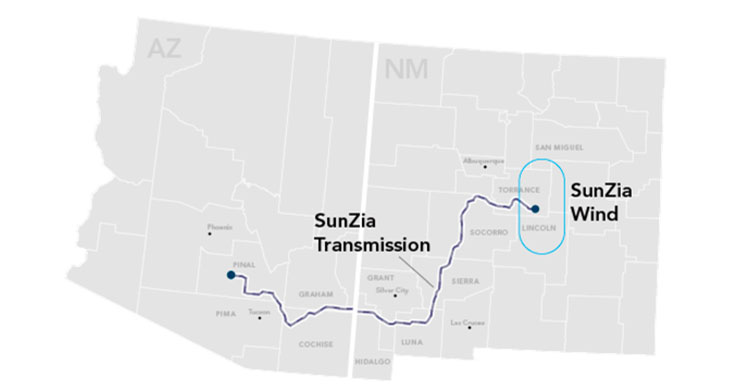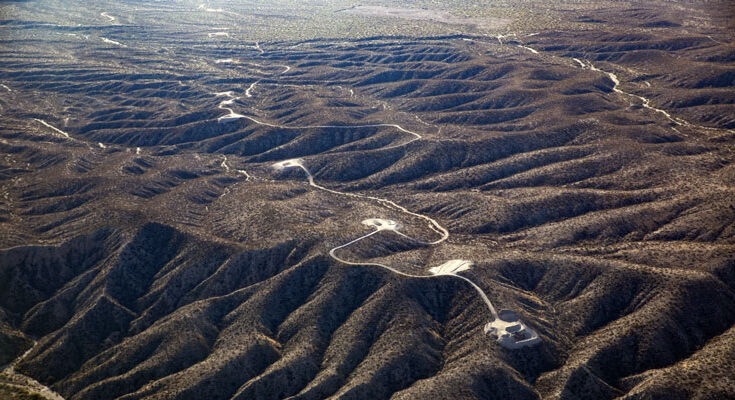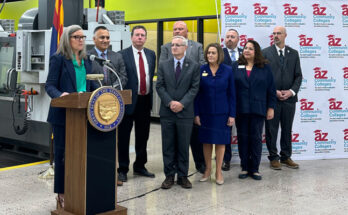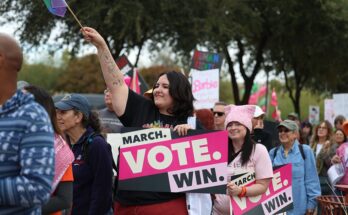Photo Courtesy Archaeology Southwest via AP: This aerial photo taken on Nov. 13, 2023, by Archaeology Southwest with a volunteer pilot and Nighthawk, a nonprofit organization, shows new access roads and town pad sites west of the San Pedro River, near Redrock Canyon. The image was included in a lawsuit filed on Jan. 17 in Arizona asking the court to halt construction of the $10 billion transmission line slated to carry electricity produced by a wind farm in New Mexico to markets in Arizona and California.
By Jon Johnson
TUCSON – The San Carlos Apache Tribe has joined with the Tohono O’odham Nation, Archaeology Southwest, and the Center for Biological Diversity, to file a lawsuit in the U.S. District Court, District of Arizona, against the U.S. Department of the Interior and the Bureau of Land Management (BLM) to stop the construction of the $10 billion SunZia wind energy transmission line.
The SunZia project is being developed by the Canadian-owed Pattern Energy and the line has been in the works for more than a decade. It would bring 3,500 megawatts of renewable wind energy from central New Mexico to roughly 3 million people by connecting to existing transmission lines in Arizona. The transmission line is planned to expand 550 miles, roughly 50 miles traversing the San Pedro Valley.
“For more than a decade, the San Carlos Apache Tribe and others have been raising alarms about the need to protect the cultural resources in the San Pedro Valley from the impacts of the SunZia project,” San Carlos Apache Tribe Chairman Terry Rambler said in a news release. “We join with the many other tribes whose sacred sites are endangered by this project in calling for a halt until our concerns are heard and addressed. We will keep fighting for a meaningful historic preservation process that actually addresses the concerns that so many have raised.”
Tohono O’odham Nation Chairman Verlon Jose echoed Rambler’s concerns, who said, “The O’odham and our ancestors the Hohokam have deep cultural and historical connections to the San Pedro Valley, with many sites of great significance. We have made BLM and Pattern Energy aware of this, but their disregard for the NHPA process has put these cultural sites in danger of irreparable harm. They must change course, immediately stop all ground-clearing activity, and work with us to protect these sites as required by federal law.”
However, Patter Energy spokesperson Matt Dallas said that the route was approved in 2015 following a lengthy review process and that it is “unfortunate and regrettable” that some parties chose not to participate in the process during the appropriate time.
Jose said that while the indigenous people of the U.S. support green energy solutions, they feel the transmission line will be culturally and physically damaging to the land.
“Tribes are some of the leading supporters of alternative energy solutions,” Chairman Jose said in the release. “However, there has been a pattern of bad faith going back many years. What else can you call the recent decision to halt construction to hold consultations, and then start up construction again? Consultations to protect sacred areas while construction is already ongoing and the route for the transmission line is already selected and non-negotiable shows clear bad faith on the part of the federal government.”

The transmission route skirts along southern Graham County as it heads westward from New Mexico and then through Cochise County and just clips the northwestern edge of Pima County before ending in Pinal County.
The SunZia Wind and Transmission project is expected to provide an estimated direct economic benefit of over $16 billion, including capital expenditures, operational expenditures, and payments to private landowners across New Mexico and Arizona. Together, the projects will generate an expected $1.3 billion in fiscal impacts that will go to governments, communities, and schools. These benefits are generated through sales and use taxes, property taxes, community benefit payments, and land payments to federal and state agencies.
The SunZia Transmission project alone will generate nearly $1 billion in expected economic impact in each of the two states hosting the project, New Mexico and Arizona, according to an independent study by Energy, Economic & Environment Consultants LLC.








